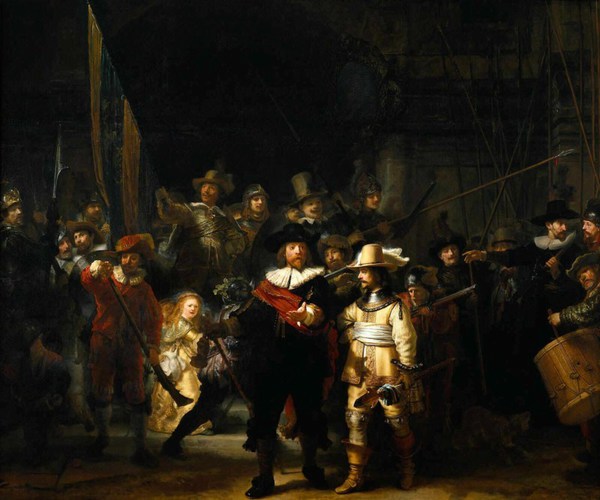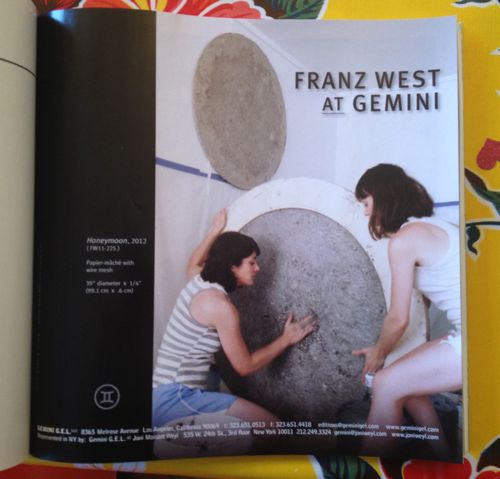
One recent night I, like you, perhaps, was flipping through a new issue of Artforum, and I saw this ad from Gemini G.E.L., the pioneering LA print foundry, for Honeymoon, a new edition by the late Franz West.
I am a longtime admirer of both Gemini and West, and particularly of West’s multiples, of which this was the first–and alas, probably the last–he would produce with Gemini. Also, how interesting that it’s being advertised in the making by these two women.
So I decided to check it out on Gemini’s website. Which is really a webshop, with a shopping cart, etc., for all their available works.
And there it is, Honeymoon, 39 inches in diameter, but only 1/4 inch thick? The one in the ad looks thicker. Papier-mache, though, is classic West. [The first works of his I saw in person were in a MoMA Projects show in, wow, 1997 (above). So long ago, but more recent than it feels. There were painted papier-mache rock-like sculptures on pedestals and furniture. I was really mystified, but then I came around to it pretty quickly.]
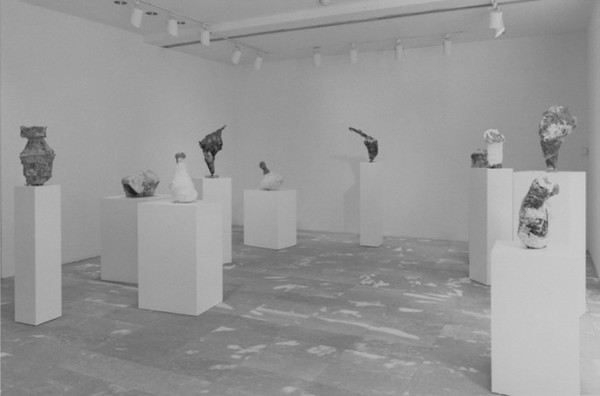
Honeymoon was “Projected,” Gemini said, as a “series of 28 unique works.” Unique, yet strangely anonymous, impersonal, and abject: a papier-mache pulp moon, that’s it. But still kind of interesting. I mean, there is so little there there, but even so, there’s something there. It’s a material minimalism, an economy. I could feel myself getting a little wistful staring at this moon, thinking of West’s life and work, ended too soon.
And I thought, I really needed to buy this Franz West, right then and there. So I did. I put it in my shopping cart, paid, and got my email confirmation. Total price: $36, plus free shipping.
Richard Prince’s Canal Zone Paintings: Now With 83% Less Infringiness!
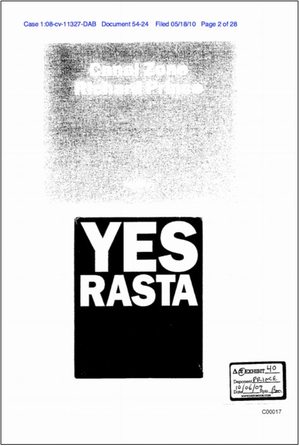
Word is definitely out, but it’s nice to see that copyright insanity has taken a step back for now.
The US Appeals Court largely reversed the earlier court ruling against Richard Prince, finding that the US District Court erred in finding his Canal Zone series paintings infringed the copyrights of Patrick Cariou. Specifically, they said that Judge Deborah Batts used the wrong standard in determining infringement and rejecting fair use.
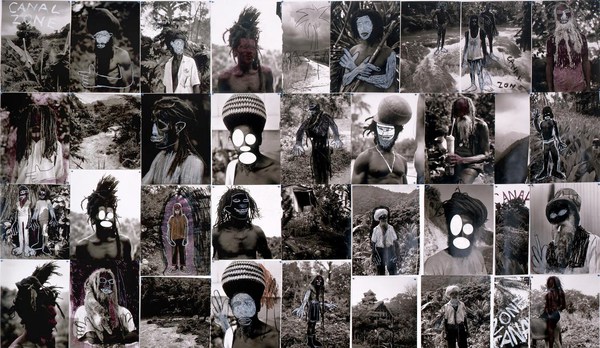
The Appeals Court judges declared that at least 25 of Prince’s paintings made obvious transformative use of Cariou’s photos. And after laying out a fairly expansive criteria for fair use, it ordered the court to re-review the other five Canal Zone works for infringiness. [That list includes Graduation (inaccurately reproduced below), Meditation (with the dude on the donkey), Charlie Company, Canal Zone (2008), and Canal Zone (2007) (above, which is actually collage, paint on book pages fixed onto a board, which was not in the Gagosian show or the catalogue; it was only shown in St. Barth’s. So why is it even covered by US law? Was it even made in the US? Is it even in the US? Is it impounded with the rest of the Canal Zone works? If so, WHY?]
In addition to citing previously unmentioned quotes from Richard Prince’s own deposition, the judges said that Prince’s intentions, or the unstated lack thereof, were not necessarily required to decide if something is fair use. Fair use can be in the eye of the beholder, specifically the “reasonable observer.” This seems both obvious, and slightly amazing to me. It also jibes pretty well with the amicus brief filed in the appeal by the Warhol Foundation.
It also means that fair use is not dependent solely on an artist making an explicit case for it. If Prince’s refusal to articulate a Koons-scale structure of critique and commentary is not required to appropriate something into your artwork, that would fortify a fair use defense. Rather than discuss art on the law’s terms, Prince has pulled the law toward considering art on its own terms.
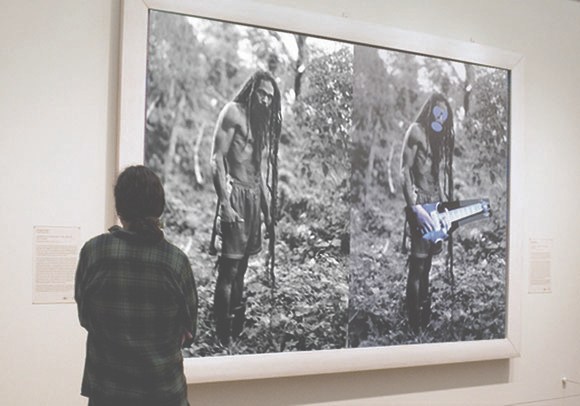
Another fascinating aspect of the decision–and by fascinating, I mean obvious and totally in agreement with me–is the court’s emphasis on the changes in size, format, and process between Cariou’s book pages and Prince’s giant inkjet/collage/paintings. [cf this discussion of scale recently] The court went so far as to create its own reference work, similar to the distorted exhibit Cariou entered, but clearer, documenting each painting and the Cariou images and fragments used in it. It’s really nice, and would be very handy for anyone wishing to make their own Canal Zone paintings. Ahem.
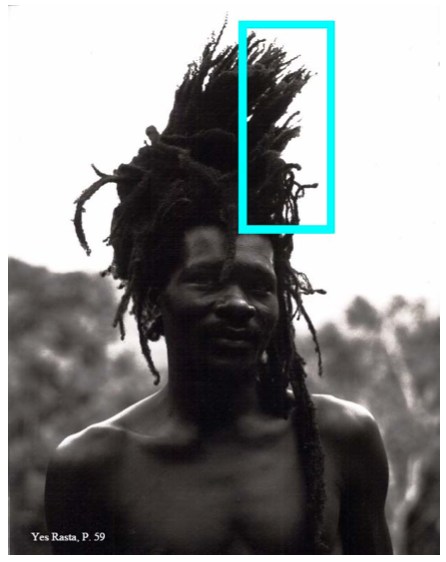
Study for Untitled (After YES RASTA, p. 59), 2013
Anyway, there is more to come, including possibly a new round of evidence and testimony about Cariou’s photos and their appearance and alteration in Prince’s work. Or perhaps someone’ll try to settle. Cariou’s lawyer’s on contingency, I believe, and 40% of nothing is nothing. So who knows how this thing ends. After more than two years since the first cluster)($#%k of a decision, though, today’s gotta be something of a relief for Team Prince.
Here, btw, is a roundup of previous Cariou v. Prince posts, including readings, reviews, and info about the book I made, Canal Zone Richard Prince YES RASTA: Selected Court Documents from Cariou v. Prince, which contains the transcript from Prince’s amazing 7-hour deposition in the case:
Early days of THE BOOK:
the five most ridiculous things about the Richard Prince copyright decision
The Richard Prince decision? You’re soaking in it!
Richard Prince’s Spiritual America
Size Matters?
Actual found blurb: “THE WITNESS: This could be a cool book.”
Introducing: Canal Zone Richard Prince YES RASTA: The Book
More documents from the case, like:
The Movie Pitch that started Canal Zone: “The Movie is called ‘Eden Rock'”
The great Amicus brief filed by the Warhol Foundation
Some CZRPYR reviews and events:
Canal Zone YES RASTA &c. reviewed in The Brooklyn Rail
HOLY SMOKES REVIEW at the Poetry Foundation by Kenneth Goldsmith, which is really humbling and amazing
Apr 2012: CZRPYR included in “Canceled,” curated by Lauren van Haaften-Schick, at the Center for Book Arts
Sept 2012: Audio & coverage of a Printed Matter talk with Joy Garnett and Chris Habib where we actually discussed and looked at Prince’s paintings, which almost never happens.
Looking a bit at the amazing language of depositions, in relation to the live staging of the deposition we did for AFC.
A great discussion of a a WTF image: Virginia Rutledge and Penelope Umbrico talking copies
Buy Canal Zone Richard Prince YES RASTA: Selected Court Documents from Cariou v. Prince online, or in person at Printed Matter.
The Richard Serra Cookie Incident
When the worst thing to happen last week was still tax day, the folks at Blue Bottle Coffee wrote about rumors circulating in the larger SFMOMA art dessert community about the Richard Serra Cookie Incident. [404 link updated to archive.org, 5/2016]
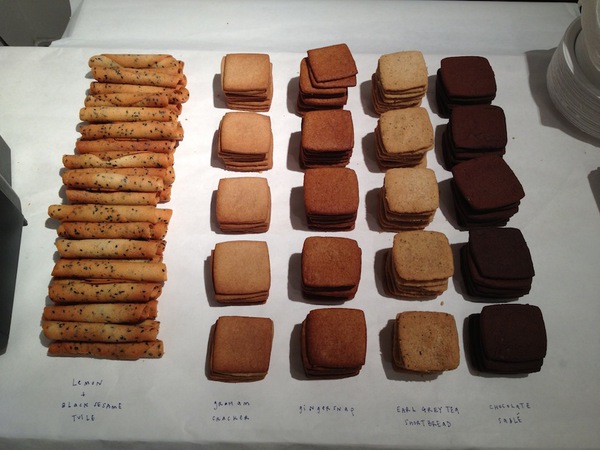
not-Serra cookie parts image by Charles Villyard
BBC is the outfit responsible for creating the desserts about art at SFMOMA. They have a new book about it. Modern Art Desserts. Available now. It does not include the recipe and assembly diagram, custom-printed on a napkin, for the 2010 cookie-based examination of Richard Serra’s 1969 prop piece, Right Angle Plus One, which is in the Museum’s collection.
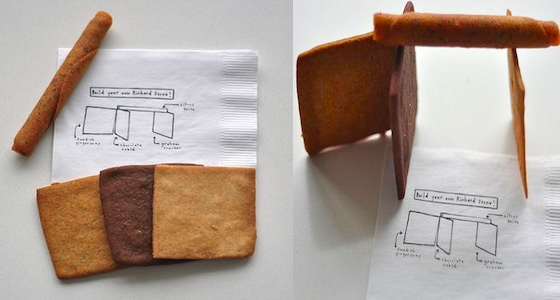
Serra, it turns out, was not amused by the cookie-based critique, as the pastry chefs found out when they met the artist during Gary Garrels’ 2011 drawings retrospective. The best line is also a call to arms:
Going through his retrospective on a routine basis while it was up was such a treat for us. It was also heart-wrenching since EVERYTHING IN THE SHOW LOOKED LIKE A GIANT COOKIE!
Right Angle Plus One is related in time and form to four prop pieces and lead rolls currently on view at Richard Serra’s show at David Zwirner.. It is now impossible to look at that show and not think of recreating it in cookies. Go ahead, just try it!
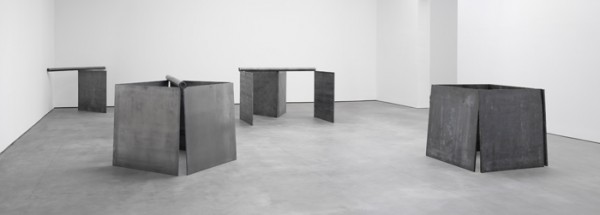
Setting The Serra Story Straight [bluebottlecoffee via wayne bremser]
Richard Serra Early Works, through June 15, 2013 [davidzwirner]
The Offices of Fend, Fitzgibbon, Holzer, Nadin, Prince & Winters
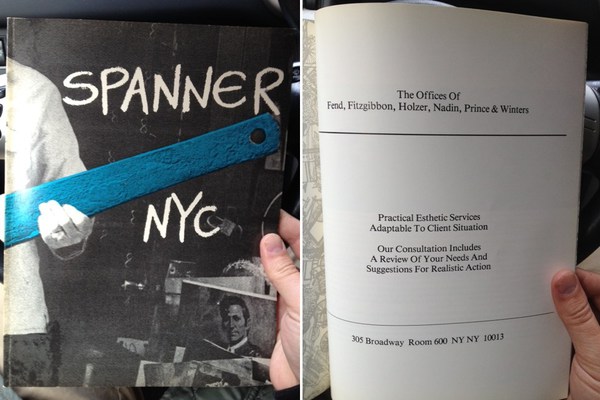
A couple of weeks ago at Printed Matter I found copies of Spanner NYC, an arts magazine published in 1979-80 by Colab folks including Dick Miller & Terese Slotkin. In the back of the third/blue issue was a full page ad from “The Offices of Fend, Fitzgibbon, Holzer, Nadin, Prince & Winters,” offering their “practical esthetic services adaptable to client situation.”
There’ve been a ton of shows related to Colab recently, and I’d known The Offices at least by name, or as a line in a few peoples’ CVs. As the recent creator of a corporate entity designed to operate in the art world, though, I guess I’ve been newly sensitized to such ventures. And I realized I had no idea what, if anything, The Offices actually did.
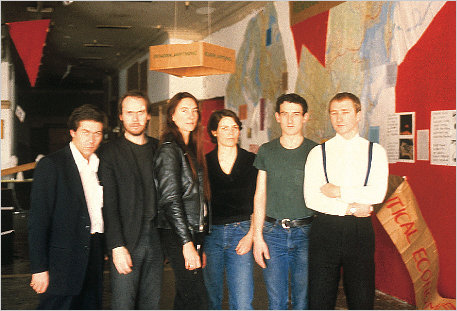
So first, the basics. The Offices seems to have been a conceptually driven, services-based, artist collaborative run on the ad agency or consultancy model. Which might be considered alongside corporate experiments like N.E. Thing, Co in Canada; Art & Language in the UK, that other UK group that infiltrated companies all over, which I can’t remember the generic name; and even the art-as-professional service work of Michael Asher. Or maybe it’s a failed utopic version of a massive sellout operation like Takashi Murakami’s Kaikai Kiki, Ltd.
The Offices sounds like it was an outgrowth of Colab, or at least created by artists involved in Colab. Peter Fend called it a “spinoff.” Here’s a photo from, perhaps, a board meeting, with all the name partners: [l to r] Robin Winters, Richard Prince, Jenny Holzer, Coleen Fitzgibbon Peter Fend, and Peter Nadin.
Actually, it could be at Peter Nadin Gallery, the artist’s studio transformed into an accretive exhibition space with Chris d’Arcangelo and Neil Lawson, where artists created work in response to the space and what had been made & shown there before. That continued for eight months from 1978-9, ending with a memorial show to mark d’Arcangelo’s death.
Or maybe it is the show on ecologically optimizing North America’s political and economic systems by reorganizing boundaries around its saltwater marsh basins. That show included work, a poster, by Fend and Holzer. I would have pegged Fend for the instigator of The Offices, but in telling the story of the basins project, Political Economies After Oil, he writes that Holzer “asked Fend to join her in a six-person artist team intent on “functional” projects.”
Continue reading “The Offices of Fend, Fitzgibbon, Holzer, Nadin, Prince & Winters”
A Domestic Proposal: At Home With Voice Of Fire
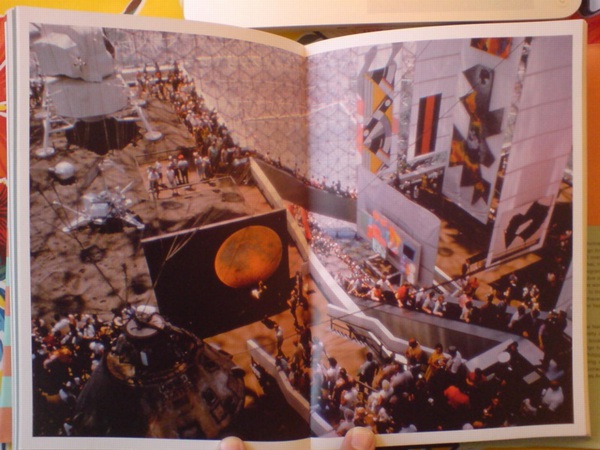
photomurals and satelloons to the left, painting to the right. image: USIA via Jack Masey’s book, Cold War Confrontations
With Barnett Newman in the air recently, I began looking back through the greg.org archives, and I found this 2009 post about the art and space objects at Expo 67, which is a great read, if only for the smackdown delivered by NY Times critic John Canaday.
I was already into satelloons and photomurals and World’s Fairs as odd, underconsidered contexts for art when it registered that Alan Solomon had curated a whole painting show for the US Pavilion in Montreal. He basically asked all the artists for work that could be hung vertically, would hold up visually in a giant geodesic terrarium, and would pretty much only be seen from an escalator. And that’s what he got.
Barnett Newman’s Voice of Fire is there in the upper right corner, looking really small between the Lichtenstein and Johns’ Dymaxion Map. Which just goes to show you, because here it is in the National Gallery of Canada, which bought it in 1989.
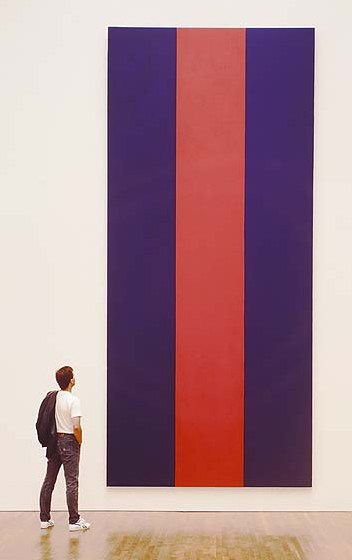
A work of confounding scale. And not without its charms. It’s not my favorite Newman, but I like Voice of Fire. It looked great in Ann Temkin’s Philadelphia retrospective. And last night, I wondered what it’d be like to live with. Because at 8′ x 18′ it is pretty unwieldy. In principle it’d be nice to have 20’+ high space at home to hang it freely. But that kind of room is really a gallery, even if your breakfast nook is just through the door.
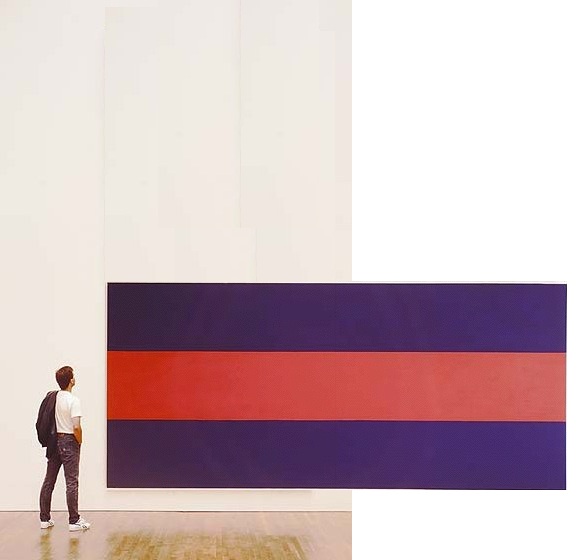
So barring that, you could turn it sideways, which is how Newman painted it. If 12×25 is too long a run of uninterrupted wall for you, though, you’re stuck. And so I wondered about cutting it down.
We sure don’t cut up paintings into saleable parts like they used to. Like they did with altarpieces [hello, Piero at the Frick] where everyone on his Grand Tour got to take home a panel or predella.
Even barely a hundred years ago, Manet’s heirs were chopping up the uncomfortably political Execution of Maximilian into more marketable groupings. And look, now most of it’s in the National Gallery [of England].
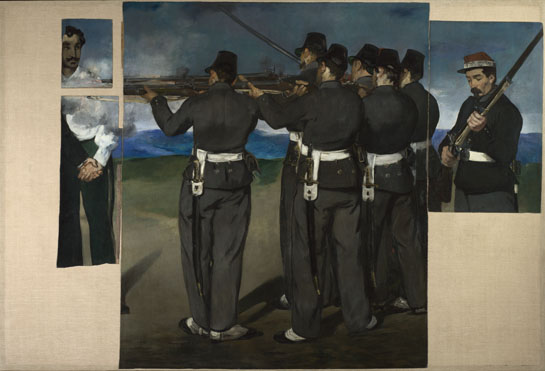
I’m not saying there’s no contemporary precedent: Gerhard Richter cut a squeegee painting into 64 little ones. And this BMW Rauschenberg campaign reminds us that Aaron Young painted dozens of panels at once at the Armory that one time, with the motorcycles.
I’m just saying maybe it’s not enough. We could do more. I understand Voice of Fire is very well known in Canada, and that the National Gallery’s purchase of it was controversial. So should Canadians ever face an arts crisis where, say a Taliban- or ayatollah-style regime takes over that is decidedly unsupportive of the kind of painting Newman practiced, I’d think cutting it down and dispersing the painting would be far better than burning it. Or bombing it, Buddhas-of-Bamiyan-style, out of existence.
Or maybe it’s just the populist thing to do. Voice of Fire would suddenly be much easier to display in a modest home. Or several, actually.
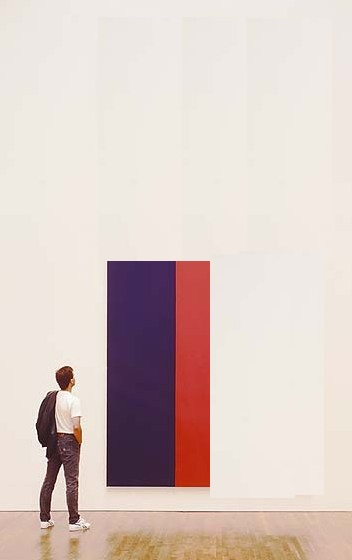
To start, you could cut it two ways: in quarters [above] or in slices [below] slices. Each approach yields four attractive, wall-filling pieces, each 4×8.5′, that preserve the original proportion while making a rich, full allusion to Newman’s overall composition. Reassembling such a group for an exhibition 500 years from now would be trivial.
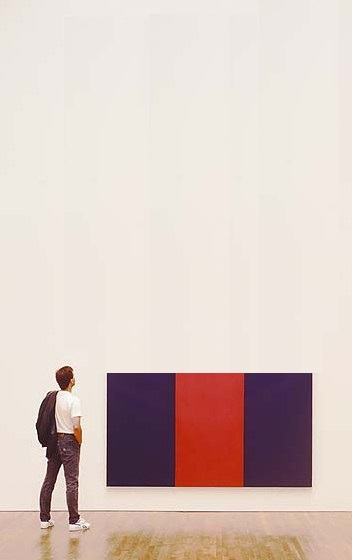
You could also cut it into 8 pieces, roughly 4×4, almost easel-size. Voice of the Fireplace. But then it seems like you’d be losing a lot to the stretchers. So, what, you’d mount the pieces? Frame them? I imagine you’d get a mix of decor decisions from the various owners. Which, yes, no, I haven’t thought through the pricing and sales strategy yet. This is really just starting out.
Seeing Stars: These Two Interviews On Aperture Right Now
Oh, nothing, just my Q&A with Aperture editor Brian Sholis hanging there online next to THOMAS RUFF. Brian and I went back and forth, discussing the photographs in Exhibition Space and how they relate to art historical developments like conceptual photography and Minimalism.
Meanwhile, Michael Famighetti interviewed Ruff for Aperture’s upcoming Summer issue, and the photographer talked about the beginnings of his Sterne series, the giant photos made using imagery from the European Southern Observatory’s Southern Sky Survey. Ruff’s work was one of the triggers for my own interest in the Palomar Observatory Sky Survey, which was the ESO’s Northern predecessor. Anyway, I think this is the first he’s discussed the series’ origins in English:
MF: Could you talk about the role of research in your work? Where does a project begin?
TR: If I see an image that attracts, upsets, or astonishes me–one that stays in my mind for a long time–I begin working. This is the starting point of the research: I try to find out how the image was created and in what context–historical, political, or social–the image belongs. After clarifying these questions I begin to create “my own” image, the image I have in my mind, the image that was triggered by the image I saw. Sometimes it can be done in a straightforward way, with a camera, but sometimes you need to reflect on how you can manage to make this technically. For example, when I had the idea of photographing the night sky, I realized that with my small telescope, I had no chance of getting high-quality images of stars, so I looked for an observatory with a big telescope where I could take the photographs myself. But they wouldn’t let me in. So I had to give up the idea of being the author of the photograph, and worked with large-format negatives from the observatory’s archive.
Yes, authorship.
And speaking of authorship [and much more], in his talk with Jörg Colberg for Conscientious, Ruff mentioned authorship and his new show at David Zwirner:
JC: I was going to ask you about that, the idea of landscape photography. Scientific photographs, say the Mars rover images, in principle are landscape photographs along the lines of early survey landscape photography in the American West.
TR: That’s where it continues. On top of that, it’s also about automated photography, photographs made by robots. That’s all part of it, the surrender of authorship… Ma.r.s. contains a bit more authorship than Stars where all I did was to select the area and to do the cropping.
All I did? After all this time, do we find out is Ruff a traditionalist?
Thomas Ruff: Photograms for the new age [aperture.org]
Interview with Greg Allen [aperture.org]
Previously: Thomas Ruff’s Sterne
Organizer-Artist vs Artist-Organizer
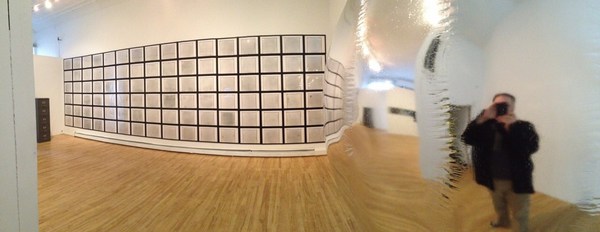
The new Frieze begins its series of artists talking about curating and being curated [sub req] with Daniel Buren’s classic 1972/1992 statement in Harald Szeeman’s Documenta 5, “Exhibitions of an Exhibition.”
I never registered it before, but Buren uses the term “organizer” for curator. Which is ironic, because at apexart several years ago, at the thin wedge of the emerging trend/abuse, they moved away from using the term “curator”–in favor of “organizer.” And the sense I’ve gotten while working on Exhibition Space is that they were seeking to get away from exactly the curator-as-artist/exhibition-as-art pretensions or associations that Buren was kvetching about in 1972.
In any case, now that I’m an organizer, and apparently the worst of Buren’s fears realized, here are some excerpts from his 1992 English translation of “Exhibitions of an Exhibition”:
Exhibitions of an exhibition
More and more, the subject of an exhibition tends not be the display of artworks, but the exhibition of the exhibition as a work of art….
The works presented are carefully chosen touches of color in the tableau that composes each section (room) as a whole.
There is even an order to these colors, these being defined and arranged according to the drawn design of the section (selection) in which they are spread out/presented.
These sections (castrations), themselves carefully chosen “touches of color” in the tableau that makes up the exhibition as a whole and in its very principle, only appear by placing themselves under the wing of the organizer, who reunifies art by rendering it equivalent everywhere in the case/screen that he prepares for it.
The organizer assumes the contradictions; it is he who safeguards them.
It is true, then, that the exhibition establishes itself as its own subject, and its own subject as a work of art. The exhibition is the “valorizing receptacle” in which art is played out and founders, because even if the artwork was formerly revealed thanks to the museum, it now serves as nothing more than a decorative gimmick for the survival of the museum as tableau, a tableau whose author is none other than the exhibition organizer.
Which, in 2003, prefaced his response to the idea, proposed by e-flux and Jens Hoffman, that “The Next Documenta Should Be Curated By an Artist.”:
Could a large-scale exhibition like Documenta be entrusted to an artist? If the tendency remarked upon here continues to hold, my response would undoubtedly be “yes.” For the artist-organizer would erase the faults inherent in the organizer-artist. For example, it would be worth betting that the announcement of an artist-organizer, whoever he or she might be, would cause an immense outcry of lamentations from the choir of the majority of all the other panic-stricken and destabilized artists.
This will be a varied and serious song. Its reasons for being will be intelligent, stupid, and revealing at the same time. They will be founded on jealousy, on the one hand, and fear of the artist-organizer’s positions, on the other. Artists, exacerbated individualists if ever they existed, would show that their corporatist spirit is not as remote as it may seem. One would notice, then, that the critiques suddenly raised by the announcement of the name of an artist-organizer had never been raised by the announcement of any organizer-artist. This a priori predictable reaction already bears within itself the fruits of extremely positive debates, for they reveal a state of fact that has been occulted for over thirty years.
And The Award Comes From…
 image via Bloomberg Philanthropies’ Facebook photostream
image via Bloomberg Philanthropies’ Facebook photostream
Congratulations to the mayors of Philadelphia, Houston, Santa Monica, Chicago [not present] and Providence for winning Bloomberg Philanthropies’ inaugural Mayors Challenge Prize for Innovation Award, thereby securing grants of five or one million dollars for your city’s innovative project, plus this wonderful trophy, created exclusively for the Mayors Challenge Prize by noted Icelandic/Danish artist Olafur Eliasson.
 image via Bloomberg Philanthropies’ Facebook photostream
image via Bloomberg Philanthropies’ Facebook photostream
As the LA Times’ Christopher Knight reported, the grand prize winner, Providence’s stainless steel trophy will be shiny, while the other winners’ trophies will have a blacker finish. All will consist, however, of a compass suspended from a circle nested in a square nested in a dodecagon, which represent, respectively, movement toward a common goal; the angle of rotation of the earth; a map; and the demarcation of time in hours and/or months.
Olafur’s Mayors Challenge Prize is the slow-ripening fruit of Bloomberg [Mayor’s and Philanthropies’] collaboration during the Public Art Fund-sponsored NYC Waterfalls project. It joins a rarified group of trophies designed by artists of the day, including:
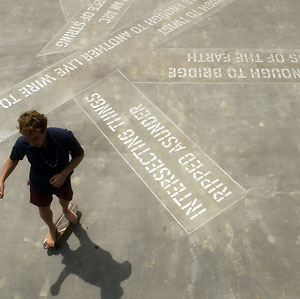
Lawrence Weiner’s adaptation in 2012 of his 2004-6 sidewalk installation Bard Enter for the trophy accompanying the $25,000 check that accompanies the newly endowed and renamed Center for Curatorial Studies Bard College Audrey Irmas Award for Curatorial Excellence.
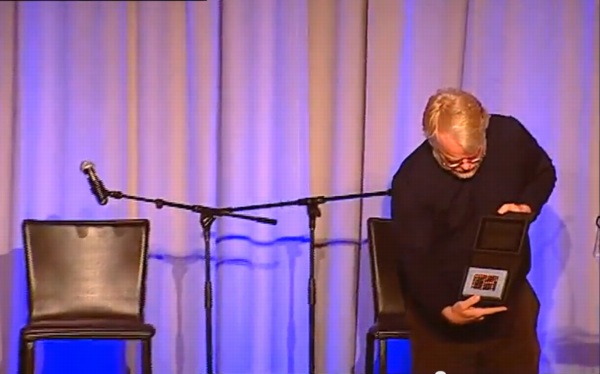
And Jenny Holzer designed Human Rights First’s Sidney Lumet Award for Integrity in Entertainment, which was presented in 2011 by Phillip Seymour Hoffman to Michelle and Robert King, the creators of The Good Wife. Here she is at the gala with the Kings and The Good Wife co-star Josh Charles. Not clear what the scrolling truism is. Maybe, “Entertainment industry’s self-regard comes as no surprise.”
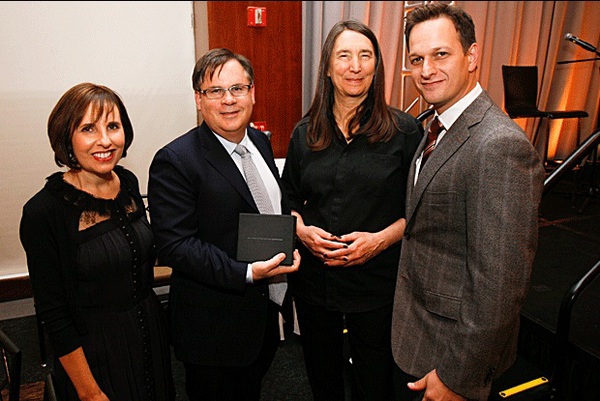
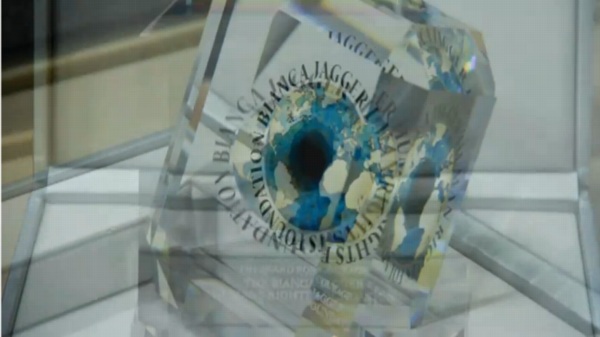
image: swarovski.tv
Also in 2011: Marc Quinn created The Bianca Jagger Foundation For Human Rights’ “Award For Courage,” in collaboration with Swarovski. It was a painting, which he did for the Foundation’s logo, which was used in the award. The inaugural recipient, Ai Weiwei, was unable to attend the gala, held at Phillips de Pury in London, where donated artworks, including Quinn’s painting, were sold to raise million of dollars. UPDATE: Quinn also designed the “Award For Leadership,” whose recipient, Chief Almir Narayamoga Surui, Chief of the Gamebey Clan of the Suruí People of Rondônia in Brazil appears also to have been unable to attend what looks to have been a dazzling, self-funding evening.
Is this a flurry of artist-designed awards? Perhaps, but the genre does have a history.
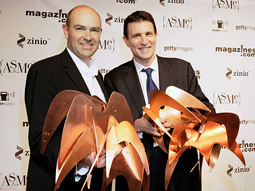
There’s the Ellie, of course, replicas of Alexander Calder’s stabile Elephant, which have, since 1966, been given by the American Society of Magazine Editors to winners of the National Magazine Awards. [That’s Chris Anderson and David Remnick hauling home three each in 2009, via adage] I can find no information on how Calder’s sculpture came to be used, nor can I see any info on the “original” stabile. Which situation I find interesting.
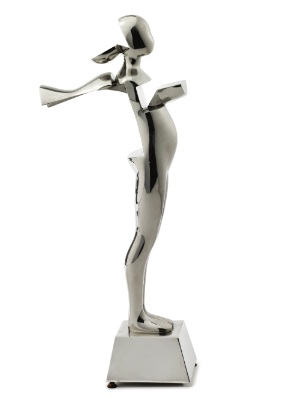
And Ernest Trova’s COUNCIL OF FASHION DESIGNERS OF AMERICA AWARD, commissioned in 1981. We read that DVF brought in the life-size version of COFDOAA to CFDA HQ. But this particular one was Brooke Astor’s, from 1989, and it was sold last September at Sotheby’s. $1,750.
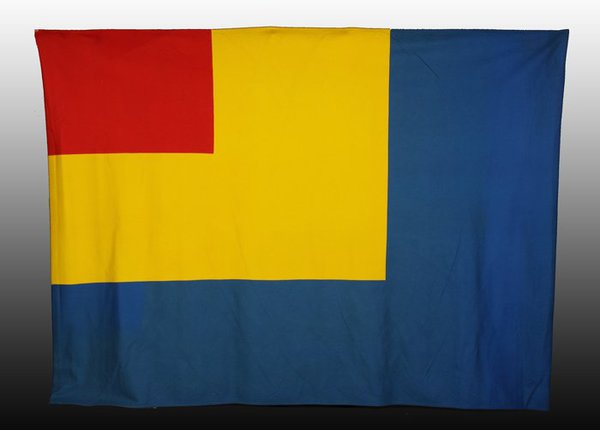
And my favorite, which has been sitting on my desktop for months now, and whose genesis has the greatest similarity to Bloomberg’s Eliasson: Rockefeller’s Kelly. In 1967, Governor Nelson Rockefeller commissioned Ellsworth Kelly to create the New York State Award. The felt banner, produced by the noted art banner publisher Betsy Ross Flag and Banner Co. in an edition of 20, was given to admirable arts and culture-related projects and institutions by the New York State Council of the Arts.
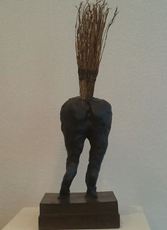
UPDATE: I’m sorry, did I say that was my favorite? It was until five minutes ago, when I discovered that in 1998 Robert Rauschenberg created the Equine Posterior Achievement Award for People For The American Way. The horse’s ass was cast in bronze by Robert Graham, and has been presented as needed to political and cultural leaders “whose abilities to misrepresent an issue, manipulate his or her followers and pander to our basic instincts reach such ridiculous levels we don’t know whether to laugh or cry.” God Bless you, Robert Rauschenberg, and God Bless The United States of America. [By 2014 Ted Cruz had won the EPAA at least twice, but I guess things have taken an unfunny turn since, because I haven’t seen any more recent winners.]
UPDATE UPDATE: via Brent @HeartAsArena comes this news: in 2010 Steve Martin commissioned his friend Eric Fischl to create the statue for the Steve Martin Prize For Excellence In Banjo And Bluegrass. Martin discussed the award on the David Letterman Show whence this screenshot was taken.
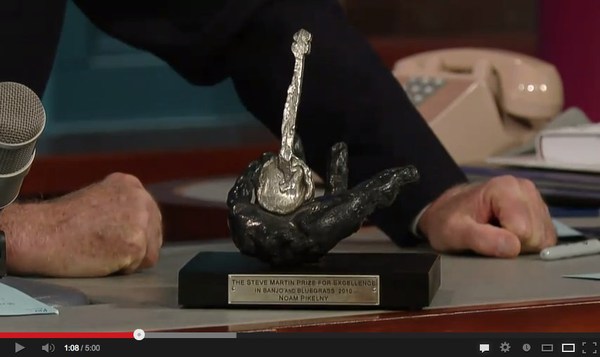
Oct 2013 Update: Americans for the Arts presented their National Arts Awards last night in New York to, among others, Dakota Fanning.
19-year-old Dakota Fanning received 18-pound, bronze Koons bunny @americans4arts gala yesterday pic.twitter.com/eDWk3EUKCf
— katya kazakina (@artdetective) October 22, 2013
And as the AftA press release confirms, Jeff Koons designed the award statue in 2009.
Nov 2013: Another award statue designed by Jeff Koons and unveiled tonight, the Smithsonian Magazine American Ingenuity Award!
This is an image of my design for the @smithsonian magazine American Ingenuity award. They will be presented tonight.
— Jeff Koons (@JeffKoonsStudio) November 20, 2013

Hey look, there’s a tiny selfie in there!
The ten winners in this, the 2nd year of the award, include St. Vincent, Doug Aitken, and Dave Eggers. Too bad the first year’s Ingeniuses don’t get one. I’m sure they got a nice plaque, though. Or a light bulb.
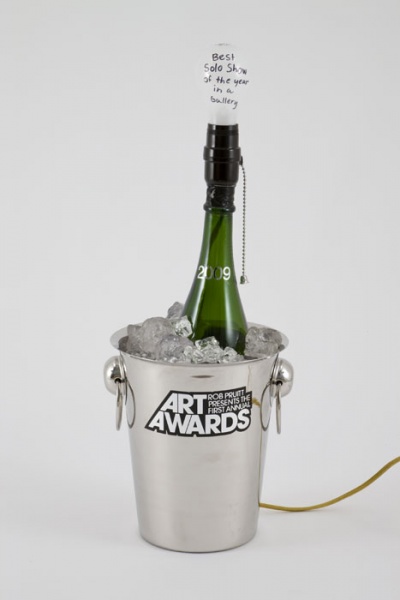
Nov. 2014 update: Did someone say lightbulb? I don’t know how I completely forgot that Rob Pruitt designed the trophies for his Rob Pruitt Art Awards, held in association with the Guggenheim in 2009 and 2010. The 2009 trophy was a champagne bucket lamp, with a light bulb that Art in America, at least, saw as a Jasper Johns reference. There were ten distributed, and more made, for sure.
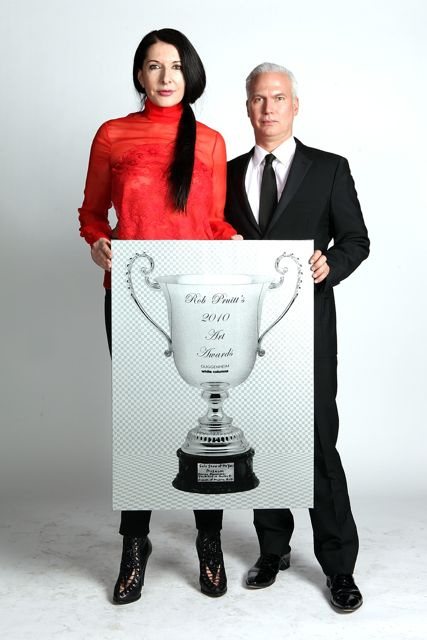
image via guggenheim’s flickr
For the 2010 trophy, Pruitt designed an engraved sterling silver cup–and then handed out screen printed paintings of the rendering. Probably a budget thing. Here is the one for Solo Show of The Year, Museum, modeled by its winner, Marina Abramovic, and her curator, Klaus Biesenbach.
Santa Monica wins Eliasson sculpture; awaits a much bigger one [latimes via @KnightLAT]
May 2018 Update: Hrag tweets from the Noguchi Museum gala that recipients of the Noguchi Award receive a desktop-sized Red Cube. Unlike the original, which is perched on a corner, the trophy version nests in a small, black base. [Also, the Noguchi Award was not initiated until 2014 (pdf), a year-plus after this compilation was first posted.]
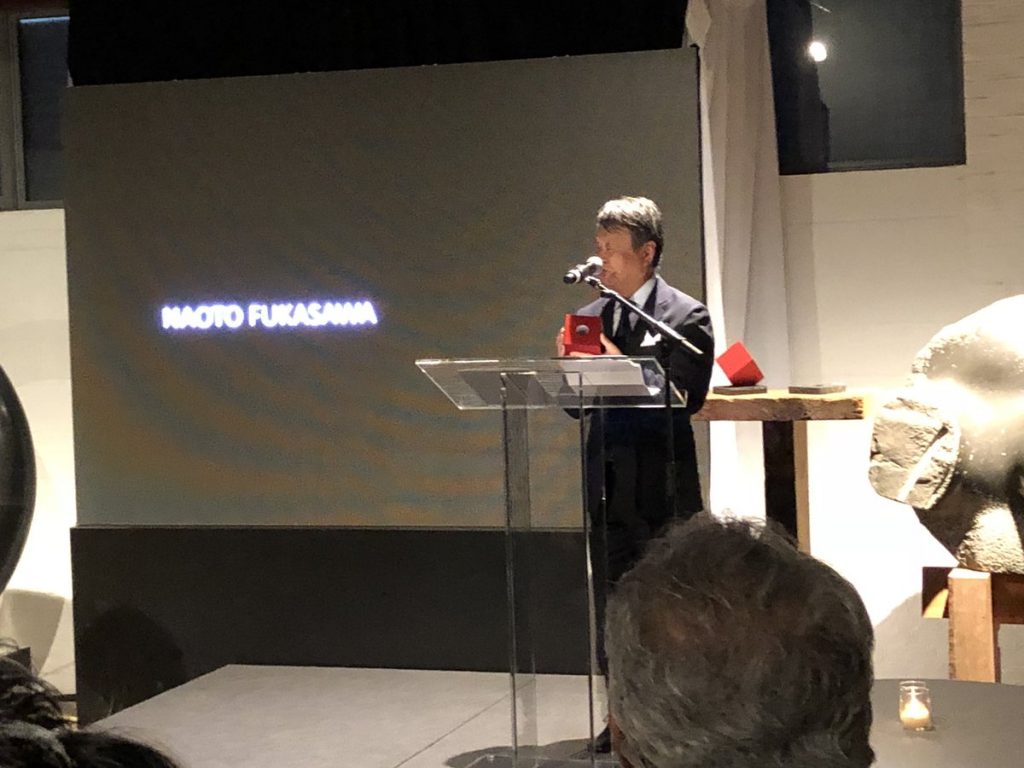
And just like that new updates beget new information. Everyone’s a winner! @RealSparklePony [accept no substitutes] tweets that the National Cartoonists Society’s Reuben Award [below] for Outstanding Cartoonist of the Year, is based on a sculpture by the NCS’s longtime honorary president, Rube Goldberg. The statue was introduced in 1954, when the award was switched from the Barney to the Reuben, and the eight previous OCOTYs, got theirs backdated. [The award ceremony is Memorial Day Weekend, so it’s coming right up!]
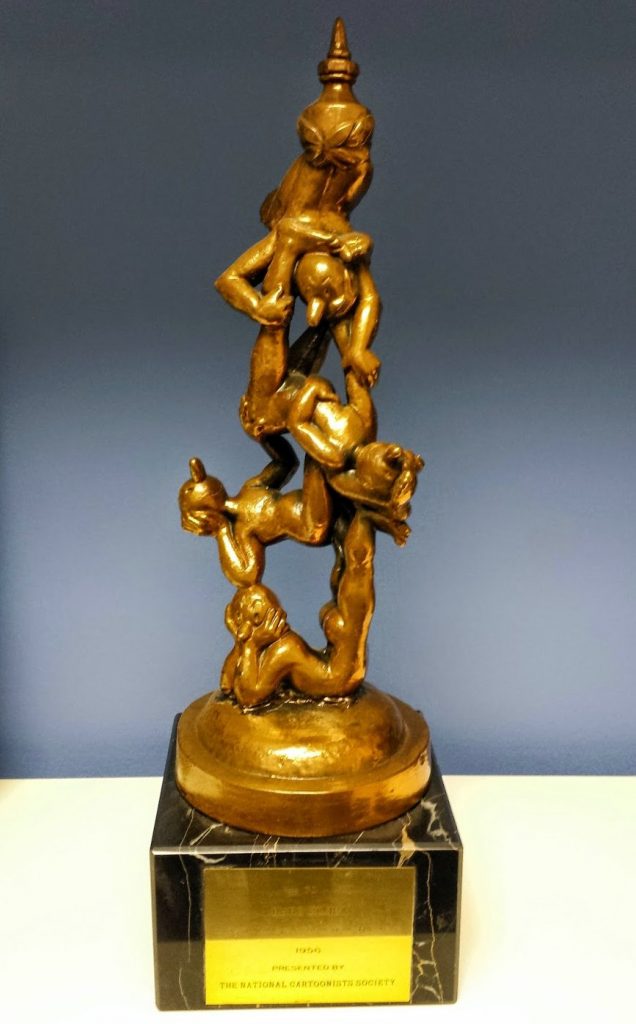
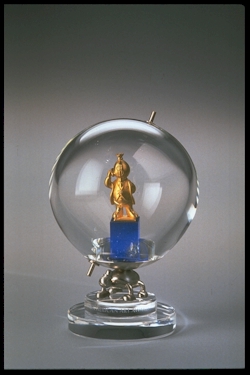
But no photos beyond 1998, which seems odd. Not as odd as the award statue they unveiled at the 2008 American Art Award gig at Hearst Tower, though. WT actual F? It is officially called Walking Whitney Museum, and it is by Laurie Simmons.
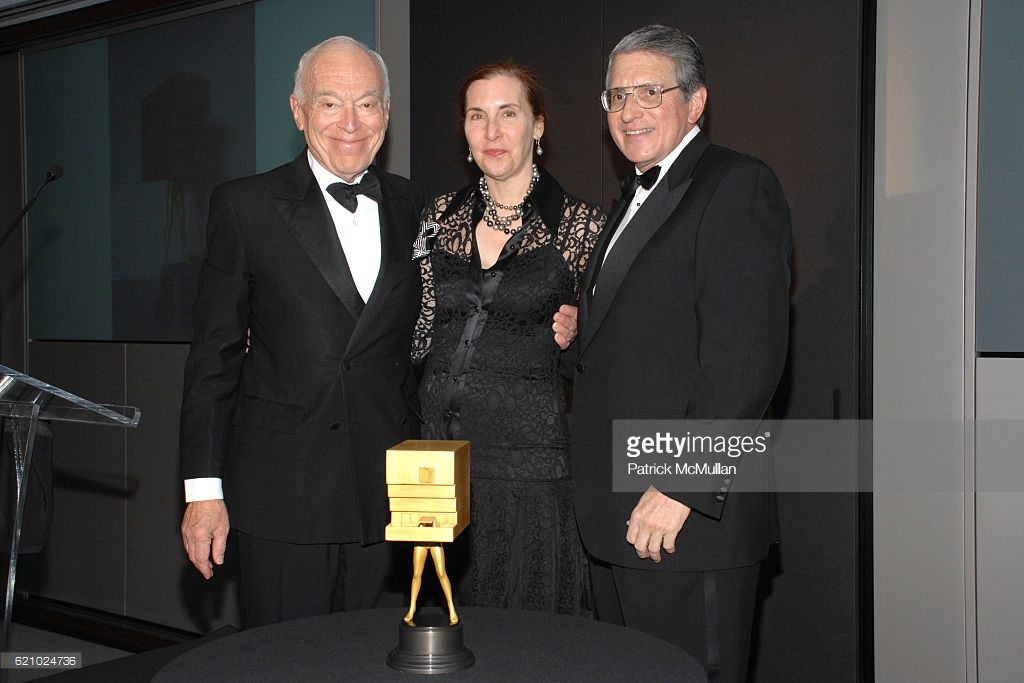
Does this mean there are 15 other artist-designed trophies for this one award? Yes, yes it does. And more. The Whitney’s American Art Award was begun in 1992, first in partnership with Cartier, and the director of the museum decided from among artists recommended by curators, who are in the collection, who will create an edition to be awarded to a corporate friend of the museum. In 2007 Whitney ISP Fellow Stéphanie Fabre wrote about the American Art Awards with refreshing candor:
The commissioned artwork is given as a prize, to honor the generosity of a rich individual or company, yet the exchange also highlights the commodity aspect of the work. The work of a mid-career artist has a decided worth, and the transaction between the corporation and the museum acknowledges this. But in the process the work also acquires a fetishistic value. Although the monetary value of the artwork given by the museum to its donor may be lower than the value of the gift given by the corporation to the museum, the work possesses a superior symbolic value, in part as a result of its affiliation with the Whitney. In addition — and as corporations know when they invest in art — art is often seen as elevated, noble, and permanent, and these associations add to the museum’s clout in the gift exchange.
And the catalogue [pdf] has all the photos. We have tapped a rich vein I am ashamed to have somehow never heard of. And here I thought I knew all the gala potlatches in Manhattan back then.
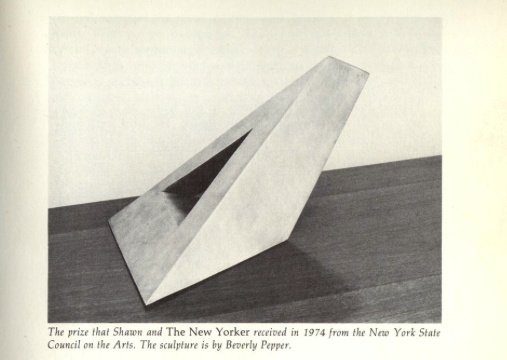
Perhaps the Whitney cribbed the artist-a-year idea from Governor Rockefeller? @TedGrunewald just tweeted an incredible, fierce, sharp, wedge-shaped steel Beverly Pepper sculpture, which was the 1974 New York State Award. This pic comes from a spread in Brendan Gill’s 1975 memoir, “Here at the New Yorker”. Wallace Shawn eyed theirs warily: “It is not only a prize; it is also a weapon.”
Glitches Of The Stations Of The Cross
So I’m reading the Guggenheim’s little exhibition catalogue for Barnett Newman’s Stations of the Cross, which, as I noted, has been digitized by the museum in conjunction with the Internet Archive, and is thus available for instant and free viewing or download.
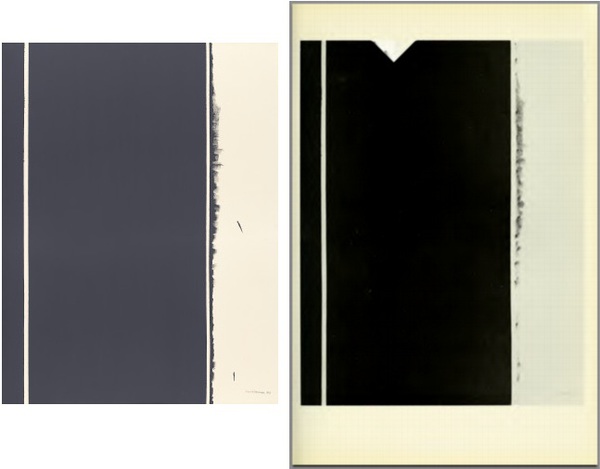
And then the little PDF constantly hangs up Preview, which is supposed to be like the most stable application in the entire OS, I thought, so what is up? And it’s always at page 31. Which, when I can see it, about half the time, has a full-page illustration of Twelfth Station [right], with a giant divot taken out of the top. Which, after a flash of doubt, I confirm [left] is not how the painting actually looks.
[Heads up: Stations of the Cross is not on view right now; it was in the NGA’s Tower Gallery, but the whole East Wing is being shut down for renovations, starting, apparently, with the gallery holding the greatest paintings.]
After repeatedly crashing, I thought, maybe I could print my way ouf of this problem, and so I printed the Internet Archive’s file to a new PDF. And watched my 1.4mb file balloon to 282mb, which obviously takes its own sweet time to open to page 1.
As well as Page 31, which is now a glitch masterpiece, that obviously, I must now paint.
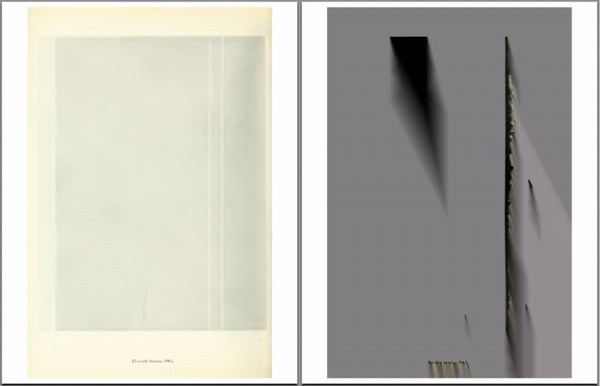
On the theory that monochromes somehow confound either scanners or compression algorithms, I checked the PDF for the Guggenheim’s 1975 Brice Marden exhibition, but it appeared disappointingly glitch-free.
The Great Piece of Merch
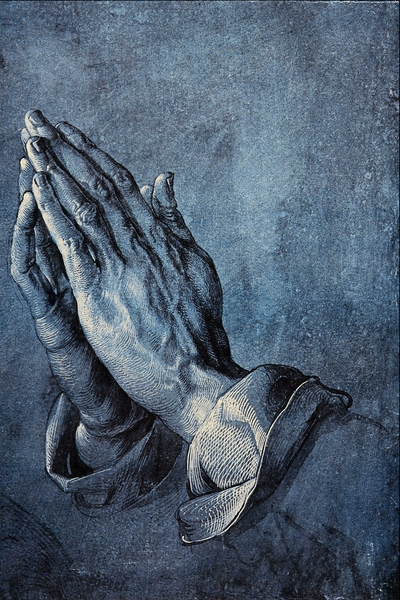
Albrecht Dürer, Praying Hands, 1508, pen and ink on prepared paper, Collection Albertina Museum
Went to see the Albrecht Dürer show at the National Gallery this morning, it was suitably fantastic. Though, perversely, I found myself taken by the seemingly least important elements of the works: the paper and the mounts. More on the mounts later, I hope.
When he painted in Venice Dürer used a new type of blue paper, carta azzurra, which was made from blue rags. But when he was home in Nuremberg, he approximated this support by “preparing” his paper. That’s what all the descriptions say: “prepared paper.”
From what I can tell, this means covering the entire sheet of paper with a blue/gray/green wash. I assume it’s due to age and the chemical alteration of some of the pigments, but a few of his drawings on prepared paper look like they have a faint, pinkish underpainting, as if he built up the ground tone with translucent layers. Which would be even more surprising, I think.
Anyway, he seems to have adopted this approach for the preparatory drawings for the Heller altarpiece, including his beyond-iconic drawing above, Praying Hands.
I searched the exhibition catalogue in vain for a more detailed discussion of this paper preparation process, but here is the conclusion of the entry for Praying Hands:
Removed from their original context, the Praying Hands were misinterpreted by posterity. They were reproduced in vast numbers and in a multitude of form, extending from reverential appreciation all the way to kitschy objects, and they have become familiar in popular culture as an expression of sentimental piety. This could hardly have been Dürer’s intention.
Though you can buy the NGA/Albertina’s Albrecht Dürer exhibition catalogue at Amazon, out of consideration for the artist’s intention, these The Great Piece of Turf eyeglass cases and scarves are available only in the museum shop.
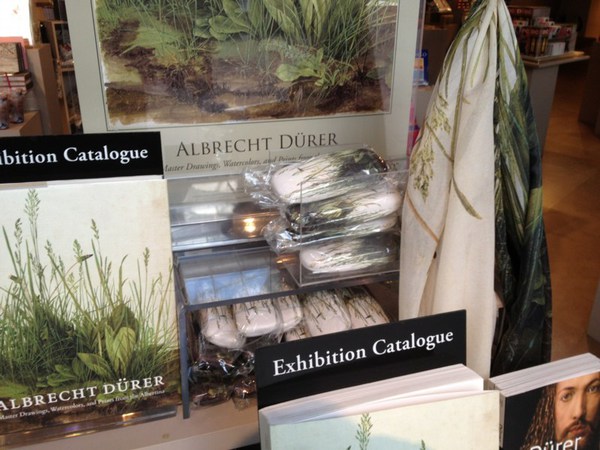
Barnett Newman Sculpture In Specific Sites
Listening to David Diao’s amazing talk on Barnett Newman at Dia a few weeks ago, and then seeing his painted references to Newman, and especially to the 1966 Guggenheim catalogue for Lema Sabachthani, the debut exhibition of Stations of the Cross reminds me that Newman’s work has been experienced and considered quite differently than it is today. [The Internet Archive has digitized Barnett Newman’s The Stations of the Cross catalogue, btw.]

Which reminded me of these old photos of Newman sculptures. The top one’s from 1967, the first installation of Broken Obelisk at the Corcoran, the museum which commissioned it. It was included in the same large-scale sculpture exhibition as Tony Smith’s Smoke and whatshisname’s giant X.
This, first edition was removed from the Corcoran in 1969 [according to Washington Post courtier/reporter Paul Richard, there was turmoil after the departure of the museum director. Go figure.] and was eventually installed at the Rothko Chapel in Houston, dedicated after the fact to the memory of Martin Luther King. But there are a couple more. Has a Broken Obelisk ever been exhibited in DC since? And I keep looking for a photo of it from the other angle, with the actual Washington Monument. I mean, that shot was possible, wasn’t it? [Yes, from the FDIC building, apparently.]
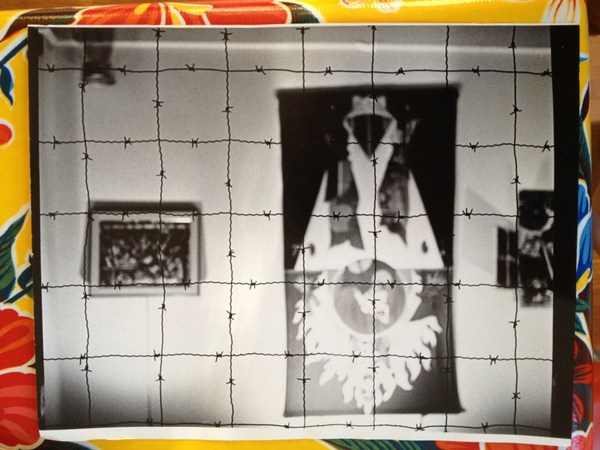
And this one, which blows my mind, is Lace Curtain for Mayor Daley, a grid of barbed wire across a cor-ten window frame. Newman made it for a series of protest exhibitions hastily organized by Richard Feigen and Claes Oldenburg, after Chicago police attacked anti-war protestors at the Democratic National Convention. [Oldenburg was one of those beaten.] Annalee gave Lace Curtain to the Art Institute of Chicago in 1989, which has exhibited it only rarely.
Like I said, the perception of Newman’s work has been quite different than it is today.
Night Watch Flash Mob
Albert Frey’s Canvas Weekend House And Other Pilotis, By Bruno Munari
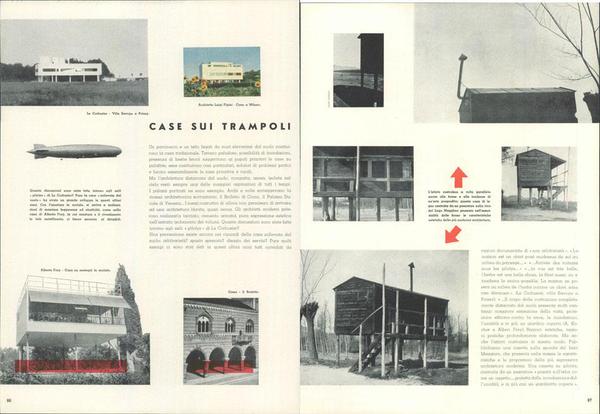
I’ve had this spread from Domus 195 on my desktop so long, I’ve forgotten who or where it came from, but the issue, from 1944, was designed by Bruno Munari.
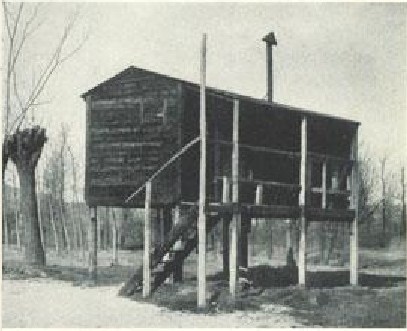
“Case su Trampoli,” or “Houses on Stilts” juxtaposes an awesome fisherman’s shack on Lago Maggiore with early modernist designs by architects from Le Corbusier to Albert Frey. Who had worked for Le Corbusier, on the Villa Savoye, in fact.
But it’s really the combination of the shack and Frey’s Canvas Weekend House on the lower left which gets me. Frey built it for and/or with Lawrence Kocher in 1933-4 at Fort Salonga, in Northport, LI, which turned into a little modernist enclave.

Did I mention it was made of canvas? After the critical success of their Aluminaire House, Frey & Kocher experimented with designs with the backing of cotton and textile manufacturers, but the only one to actually get built was Kocher’s own house.
Marine canvas was stretched horizontally over a redwood frame, insulated with aluminum foil, and nailed, painted & sealed. Joseph Rose’s Frey monograph says it had to be resealed every three years, but I can’t see how long the canvas house actually stood.

The most detail I’ve seen online comes from Tania Gonzales Gonzales’ series of blog posts, an assignment to analyze the house’s structure and propose an addition to it.
Mirror, Mirror
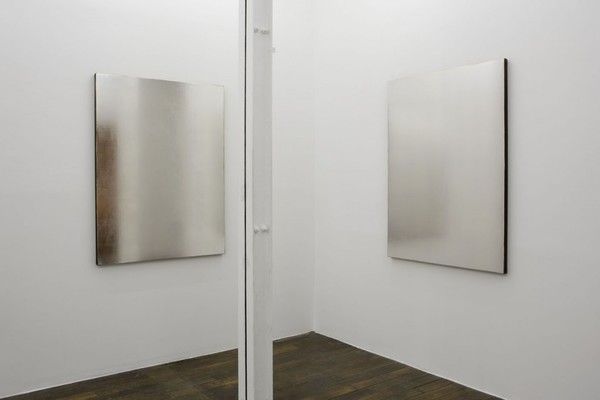
OK, I am a bit in love with Jacob Kassay right now, in my head.
In Art F City Eva Heisler reviews Kassay’s current show at Art:Concept in Paris [above], his second, and it looks remarkably like the first, in 2010 [below].
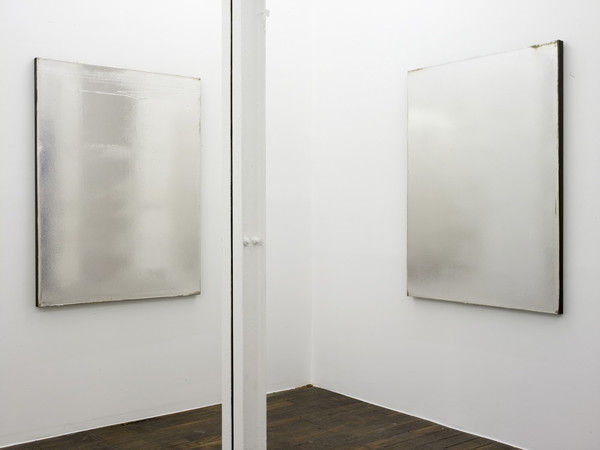
Do you see what he did there? Did he really just answer the perennial art journo question about how he’ll top with the extraordinary popularity of his electroplate paintings by just cold restaging an entire show of them? Apparently, no.
Heisler explains that these are not Kassay paintings, but “canvases,” “props in lieu of paintings.” In fact, they’re in exactly the same lieux and same dimensions as Kassay’s first show. And the installation shots of 2013 are almost all identical to those of 2010. And despite what it looks like, this situation Kassay has set up is one in which, as Heisler astutely puts it, “his paintings are present only through their staged absence.”
But these present absences, these “not paintings,” are–are you sitting down?–not for sale. They will be destroyed after the show. At least the canvases will be. The “stretcher bars (will be) recycled.” Which seems like an odd detail, but hey.
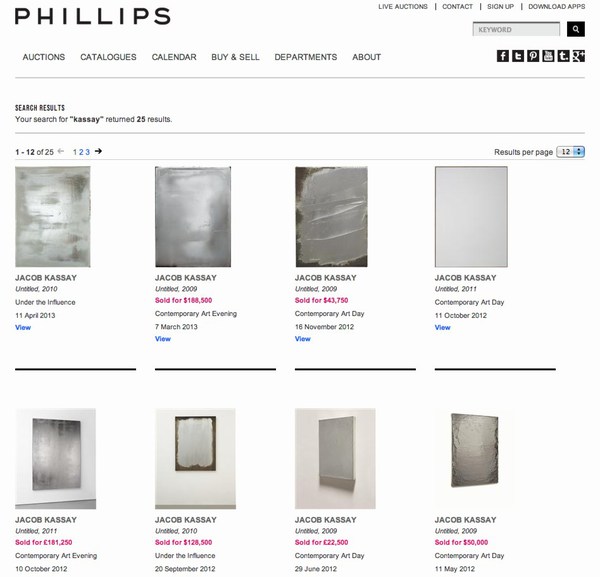
There were actually not 25 paintings at Phillips, only 17, with one sold twice. Which, holy smokes, nice placement. Does anyone hold onto these, ever?
And not only do these new canvases have a uniform, non-gestural, more mirror-like facture, Heisler reports, again, kind of oddly, that “this time the artist did not touch the surfaces at all.” Which would seem like the least determinative factor possible for a non-painting these days, until this one:
The fact that Kassay’s mirror objects are emphatically “not paintings” and earmarked for destruction implies that the definition of what counts as a “Kassay painting” has to do with its entry into the art market. If so, then it is an irony that the artist’s attempt to evade the market in fact reaffirms its powers even to name what counts as “a painting by Jacob Kassay.”
Which, what? Why? No way, not even. Kassay can outsource or not sell or destroy what he wants. But the only reason Kassay’s “not paintings” are not paintings is because Kassay says they’re not paintings.
What Heisler calls “deflection” I would see as negation. Looking back, and following the artist’s chosen mediations, the Art:Concept show reflects [sic] a sustained strategy of negation and “staged absence” as a constructive part of Kassay’s practice.
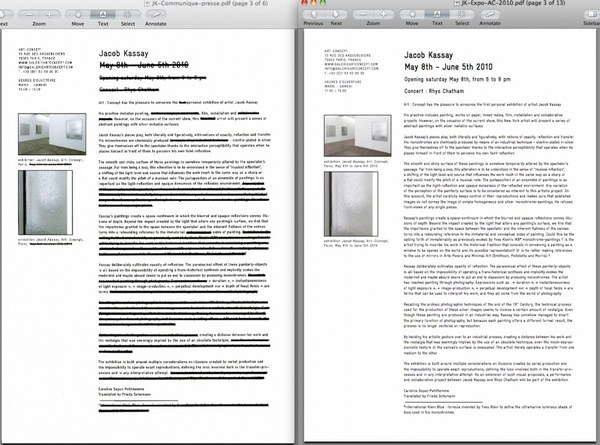
Art:Concept’s press release for the current show is, so to speak, Exhibit A. Just as the 2013 canvases bear striking resemblance to the 2010 paintings, The new press release, too, [left, pdf] turns out to be an excised, barely augmented, near-replica of the old [right, pdf] And you know what the funniest thing about Kassay in Europe is, it’s the little differences.
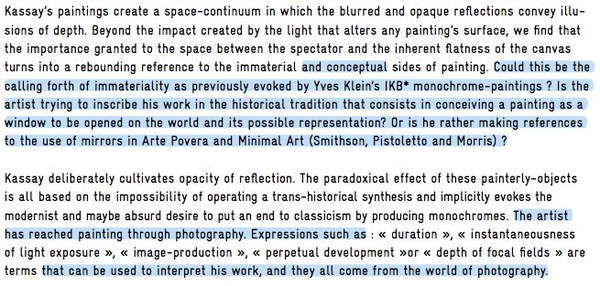
To make it easier to see what’s changed, or specifically, what’s been deleted, negated, from Kassay’s presentation, I converted his strikethroughs to highlights. You can download the complete, highlighted pdf here. What’s erased crossed out? Well, data [Dates, “New York,” “collaboration,” and “works on paper,”] but also things like “industrial,” “chemical,” “conceptual,” and every reference to photography and his monochrome and mirror forebears such as Yves Klein and Robert Smithson. Also blacked out: any privileging of “the perception of the painterly surface,” and particulars of how “the artist carefully keeps control of their reproductions.” Which, he may not want to talk about it, but since the 2013 installation shots match perfectly to the 2010 photos, I think it’s safe to say he still cares.
It’s a stretch, perhaps, but there seems to be a non-trivial overlap between what was blacked out and the terms, references and concepts initially used to hype Kassay’s paintings in auction catalogues and the media. [“Whilst Kassay uses industrial techniques, they retain an engaging, painterly quality.”]
What’s less speculative but feels quite instructive is to see what stays:
“the modernist and maybe absurd desire to put an end to classicism by producing monochromes.”
“…creating a distance between his work and the nostalgia that was seemingly implied by the use of an obsolete technique.”
“…multiple considerations on illusions created by serial production and the impossibility to operate exact reproductions; defining the loss involved both in the transfer-processes and in any interpretive attempt.”
The Art:Concept show also invites a reconsideration of Kassay’s just-ended exhibition in New York, Untitled (disambiguation) [or as I liked to call it, “leftovers at The Kitchen”], which consisted, remember, of stretched scraps of canvas from which his earlier paintings had been cut. The staged absence of paintings.
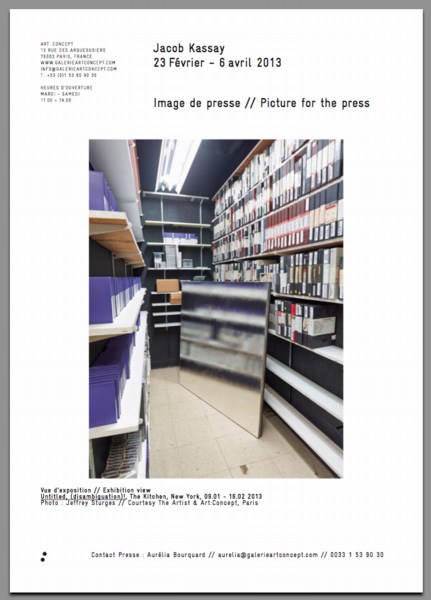
It also included several silvered paintings, installed/photographed in conspicuously offhand, even marginalized spaces: propped in the foyer, behind a column, or in a storeroom. These images are, in fact, included in Art:Concept’s press release.
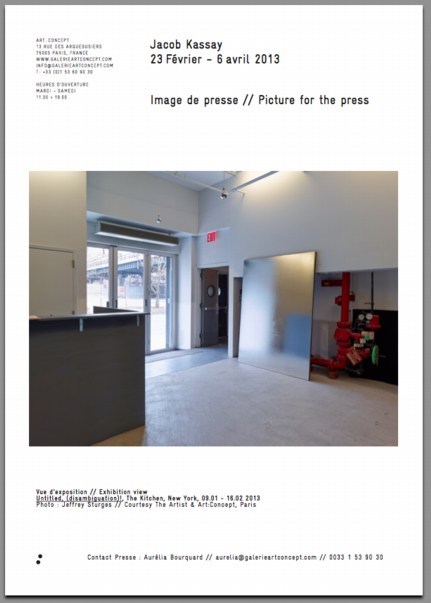
And now that you mention it, their surface looks as uniform and non-painterly as the “not paintings” of Paris. Did anyone look into The Kitchen’s mirrors, to see what their status was? Were they, too, “props in lieu of paintings”? Were they dismantled or destroyed? Were they for sale? Is there any place better than the gallery of a performance space to stage absence?
I looked back at reviews and such, and found that, again, the press release had been altered, this time without leaving a trace. The early text preserved–along with Ben Davis’s mug–in this photo contains facts about the making of which are omitted from the archived version. [pdf] What had been explained and presented as the artist’s intent was eliminated, transformed through negation into historical hearsay.
Which makes me think again of the Henry Codax Incident last year. That’s when Christie’s, citing Gallerist NY’s report, described a dark grey monochrome by the fictional artist Codax as the product of a collaboration between Kassay and Olivier Mosset. Kassay protested, and insisted that Christie’s read a statement before the auction “disassociating his name” from the painting.
So in addition to Codax paintings which are “not Kassay paintings,” we can add canvases in a Kassay show which are “not paintings.” To paraphrase John Cage, Kassay has nothing to paint, and he’s not painting it.
But just as Rauschenberg demonstrated erasure as a generative act, Kassay gives hints that negation for him is constructive and not repudiation or “deflection.” Art:Concept’s current Kassay slideshow also includes two non-not-painting objects: used French library books with prismatic acrylic wedges inserted into them. One is a collection of work by the late Greek poet Constantin Cavafy.
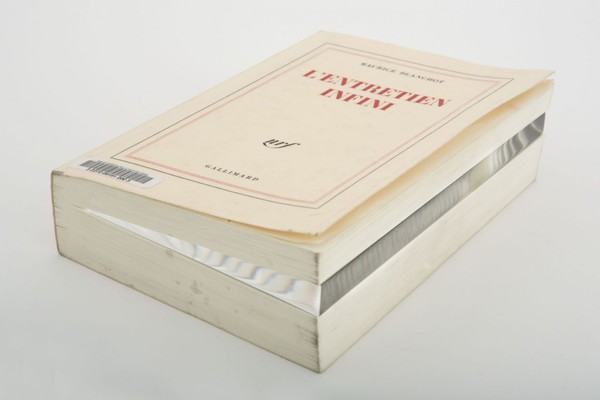
The other: l’Entretien Infini, The Infinite Conversation, by philosopher/theorist Maurice Blanchot. Blanchot and Mallarmé argued that the power of language derived from its ability to negate a thing and replace it with an idea. And that both thing, the disappeared/negated thing and the idea that replaced it were equally valid, constant, and stable. And that the idea was even moreso, because the thing was subject to change. So really, instead of looking at the not paintings as destined for destruction; we should see them as ideas which will never be tarnished by time, atmosphere, or white-gloved flippers.
Jacob Kassay at Art : Concept, Reflection or Deflection? [artfcity]
Jacob Kassay, 23 février – 6 avril 2013 [galerieartconcept.com]
Jacob Kassay, 8 mai – 5 juin 2010 [galerieartconcept.com]
Previously: Henry Codax at Auction; also, Speculation
Also, Jacob Kassay, Johns & Rauschenberg, and collaboration
Makin’ Copies

“Courtesy Flickr and the Artists; Illustration by BLOUIN ARTINFO”
The new issue of Aperture has a great discussion between Penelope Umbrico and Virginia Rutledge about one of my favorite WTF aspects of the Cariou v. Prince case: the fact that the primary visual evidence of copyright infringement used in court is not the paintings themselves, but photocopies. When the fair use/recontextualization/mediated imagery chips are down, the only thing being looked at is flattening, scale-destroying Xerox pairings made by a friend of Patrick Cariou.
Anyway, hot foot it over there right now, but before you go, just check out this amazingly dishonest image of a page from a book and a 6-ft painting. It’s “Courtesy Flickr and the Artists; Illustration by BLOUIN ARTINFO,” and accompanied a Julia Halperin story from last year wherein “BLOUIN ARTINFO analyzes how the Prince v. Cariou case has shaped views on the issue of appropriation.” Which, SRSLY, BLOUIN ARTNFO, analyze thyself.
It’s almost enough to make me start turning my pages from my copies of Cariou’s Yes Rasta book into tiny, exact collage replicas of Prince’s paintings. Stay tuned.
The Image World Is Flat: Penelope Umbrico in conversation with Virginia Rutledge [aperture.org]

